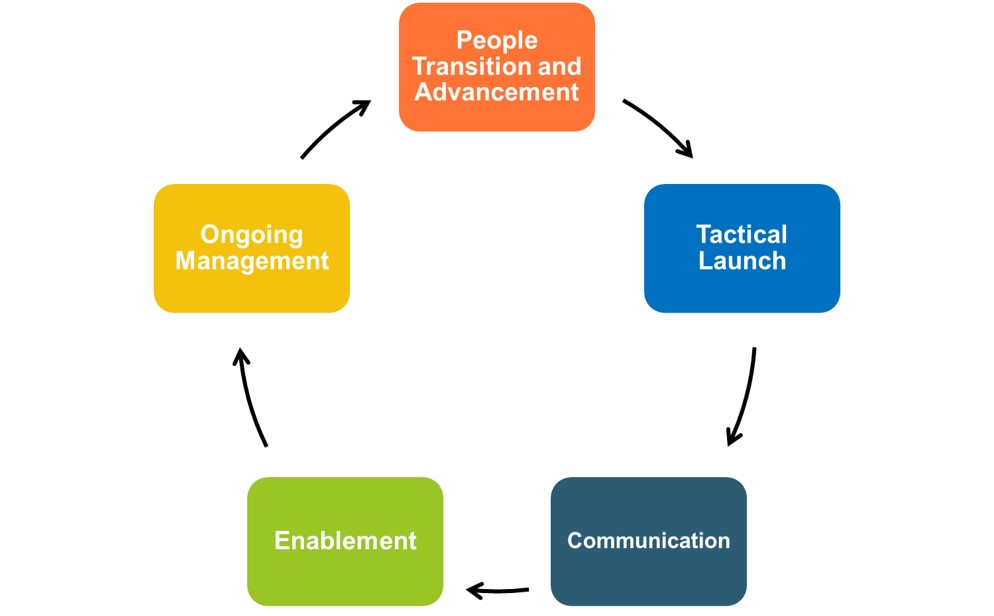Change Adoption for Effective Change Management

Change Adoption
Technology and data are fundamentally changing how we do business. Revenue and sales organizations recognize the constant need to change and innovate. However, designing new go-to-customer models, enablement programs, processes and management programs is difficult and involves a significant amount of effort. Furthermore, the results of these programs often fall short, even with the best design. If the organization refuses to change its behavior, introducing new practices can create confusion and produce mixed results.
Any change initiative must start and end with thinking about Implementation and Change Adoption.
Change Management Vs. Change Adoption
At the most fundamental level, change is a movement through three phases, Current State →Transition State →Future State. It is not enough just to “manage change” through these phases—it is imperative to “adopt change” and make the transformation a core aspect of the organization.
Change Adoption is critical for maximizing the impact new initiatives can have on supporting strategic objectives, motivating the organization and encouraging differentiated results. Rolling out a new program and ensuring adoption are two different things. Having a proper change adoption strategy is the first step to being successful in this endeavor. For any change effort to completely take hold, the leadership team must answer the following:
- How do we make this stick?
- How do we measure and show tangible results?
- How do we continue to learn and evolve?
5 Areas That Ensure Successful Implementation and Change Adoption
Alexander Group has found that five key areas increase the likelihood of a successful implementation and change adoption. Target these areas to answer the key questions your leadership team must face regarding making the changes stick, establishing measurement tactics and facilitating continued learning.
- People transition and advancement: Construct strategic and tactical plans to determine leadership and talent capabilities to fulfill new requirements and accelerate ramp time.
- Tactical launch: Define the implementation roadmap; organize team roles and responsibilities, design and conduct launch events, prepare rapid execution program.
- Communication: Craft impactful leadership messaging, internal and external communication strategies, ongoing value reinforcement, review and feedback loop.
- Enablement: Develop the tools, playbooks and workshops to reinforce and support execution excellence of future state vision.
- Ongoing management: Create post-launch success metrics, test and learns, course correction, dashboards, executive reviews and course correction action plans.
Implementation and Change Adoption Framework
Where to Focus for Change Adoption
When it comes time to implement the vision, selecting the correct change model and engaging appropriate influencers are key to effective adoption.
Companies must decide on a change model—either organic (leveraging existing capabilities) or inorganic (acquiring capabilities via purchase or partnership). Change models establish a concrete direction that drives the Change Adoption process.
Companies must also engage the right influencers within the organization. The executive sponsors and the new generation of team members are most likely to embrace change. These flexible groups often receive the most attention during Change Adoption. Middle management—the team with the greatest influence—is often overlooked.
Focus on the model and middle management as foundational elements of Change Adoption:
- Model: Vision and leadership will not be enough. People and organizational capabilities are important enablers. Successful transformation starts with an introspective and decision-making approach around what capabilities to build versus those to acquire. The same goes with people. Companies need talent to implement change. Successful transformations feature a balance of both new members as well as investments in educating existing team members.
- Middle Management: Limiting participation from key influencers within middle management will stall the speed of change. Managers encourage agility and adaptability. They drive the learning of new capabilities within the rest of the team.
Implementing Change Into Your Organization
Whether you’re undertaking a full-scale sales force transformation or fine-tuning a specific program, your plan is only as strong as its implementation. There are multiple dimensions of successful Implementation and Change Adoption:
1. Sales Playbooks
Develop comprehensive playbooks to guide sellers and other stakeholders, as well as tools and workshops to engage, educate and help with implementation and adoption.
2. Sales Enablement
When you give your revenue and sales organizations relevant content, training and tools, you enable success. Conduct thorough reviews of the related processes, tools and usage to ensure your support systems are in line with your revenue growth strategy.
3. Collaborative Launch Design
Define the full details of how your organization will go from current to proposed state, then develop and implement a test-and-learn program. Conduct surveys to determine your organization’s readiness for change and an ROI analysis to estimate the direct costs, sales uplift and resulting profit.
4. Communication
Effective communication is essential to rolling out a new program. Create a management model for the overall communication process and cadence—supported by presentations, documentation, launch events and executive reviews. The result: all stakeholders have a clear understanding of the plan, its purpose and their role.
5. Decision Support
Successful implementation requires continuous adjustments—driven by data. Through scenario modeling, retrospective assessments, monitoring and data management, provide the insights you need to make ongoing leadership decisions and empower your organization with a culture of continuous improvement and sustainable change.
6. Outsourcing
If your team lacks the expertise or resources to support change, supplement your team to provide revenue leadership, enablement and operations support.
Ongoing Change Adoption Best Practices
Leaders of organizations who have successfully executed their Change Adoption roadmap offer the following advice:
1. Invest Early
Identify those critical to change adoption at the onset. Involve stakeholders at the start of the process. Whether they participate in interviews, working sessions, sit on advisory boards, or something more material, involve those owning implementation and users early in the process. This will often include marketing, sales and service line managers. Bring in the user community and establish evangelists.
2. Relentlessly Communicate
Articulate the purpose and expected outcomes clearly, consistently, broadly and often. Set expectations that adoption is the only option. Ensure the organization at large knows and understands the vision and intent. Tune messages to each audience and leverage peer evangelists for delivery. Use multiple channels—solely using email and corporate memos will not cut it. Treat it as a new product introduction, where you likely wouldn’t launch a game-changing product with a marketing automation email blast.
3. Train, Train and Train
Set up a 12 to 24-month program for current team members and incorporate the model in new hire onboarding. Ensure new and existing team members understand the new operating model and how it impacts them. Sustain training until traces of old ways of operating no longer linger.
4. Set Goals and Monitor Performance
Ensure those owning implementation and users are properly directed and motivated. Set adoption and outcome goals. Communicate how they are expected to achieve those goals. Report on progress and incorporate performance in review cycles.

Execute Change Adoption With Alexander Group
Alexander Group has the experience to guide you through each element and step of Implementation and Change Adoption, as well as adoption management. We'll leverage our research and multi-industry expertise to assist you and your firm to ensure your get the results you expect from your transformation or a specific initiative. For more information, please contact us today.

